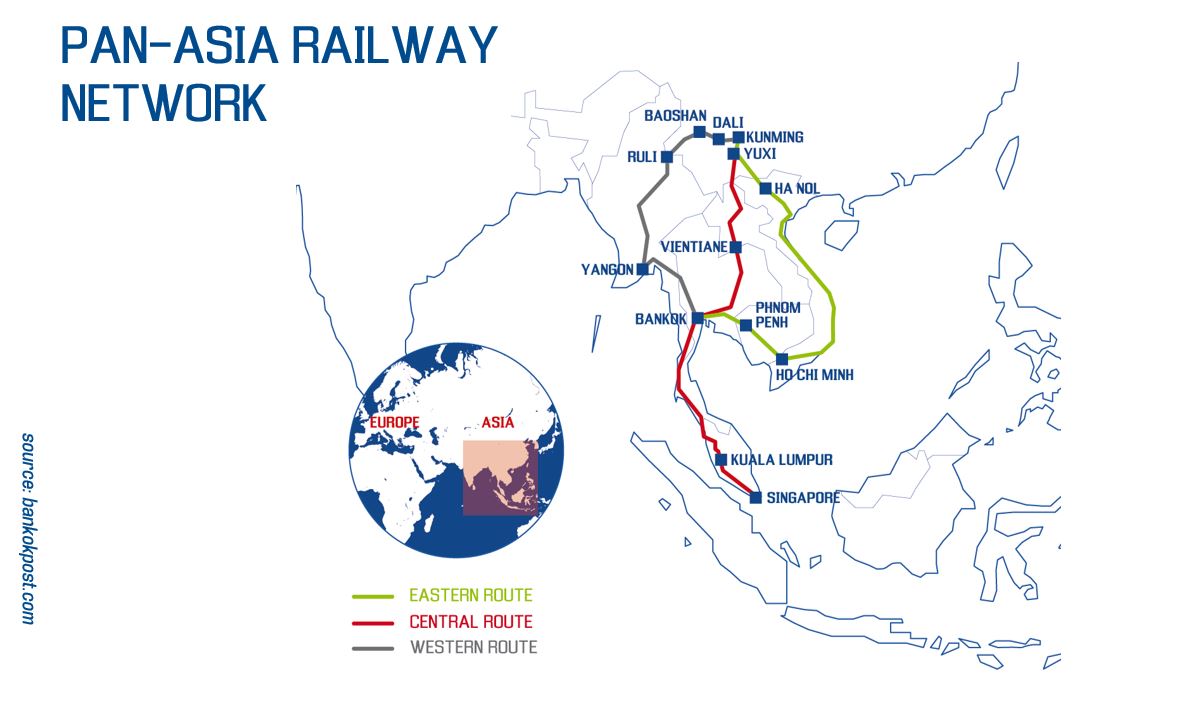La rete ferroviaria ad alta velocità che collegherà Kunming a Singapore contribuirà ad aumentare l’integrazione economica in Asia orientale
The Kunming-Singapore railway, also known as Pan-Asia Railway Network, is one of the most ambitious infrastructure projects currently under construction in Asia and it was designed with the aim of connecting Southeast Asia to the southern provinces of China. Consisting of a huge network of railway lines, with some of them already operational, once completed the Pan-Asia Railway Network will connect the city of Kunming, capital of the Yunnan province and the economic center of Southern China, to Singapore, passing through Thailand, Cambodia, Vietnam, Laos and Myanmar.
The project’s foundation dates back at the end of the 19th century, when French and British colonial powers agreed on a joint development transport network in order to connect southwestern China to the Indochinese peninsula. The goal was to facilitate the European’s export of goods and manufactured products to the region, as well as to exploit the huge mineral resources of Yunnan; however, the many conflicts that occurred over the next century dealt a severe blow to European commercial ambitions. After the Second World War, the newborn countries in the area were too busy to achieve their independence processes instead of building a functional transport system. Also due to the low economic importance of Southeast Asia which did not justify such a huge investment, the project was delayed for decades.
At the very beginning of the 21th century, China has emerged as the new superpower in the continent. All the countries in the area have benefited from its impetuous economic growth, so much so that in the early 2000s both ASEAN and China realized it was time to improve regional infrastructures. With the launch of the “Belt and Road Initiative” in 2013, the strategic relevance of Kunming-Singapore has further increased. The Chinese government has invested significant amounts of money with the ambition to connect the whole continent: Beijing is focusing strongly on Southeast Asia, directing almost a third of the total investments of the BRI towards ASEAN countries.
Several projects have been proposed to complete the Pan-Asia Railway Network, which today sees three giant routes under construction: the main section will link Kunming to Singapore via Bangkok; the eastern route from Kunming to Ho Chi Minh City via Hanoi; and the western route, from Kunming to Yangon in Myanmar, still in its planning stage.
The Pan-Asia Railway Network will have a significant geopolitical impact for the ASEAN countries located in the Indochinese peninsula: a project of this magnitude represents a unique opportunity to strengthen their economic ties within the region and with the rest of the international community. The approximately 5,500 km of future railway lines will contribute to increasing circulation of goods, people and ideas in East Asia in the next decades, generating a positive outcome for all the parts involved.
However, such a huge project doesn’t come without any significant drawbacks. In many cases there was no lack of delays or postponements in the implementation phase due to various structural difficulties. For instance, the complex geomorphology in Myanmar and Laos’s territory is causing a lot of difficulties for local engineers and, on the other hand, various ethnic groups living along the route of the new railways are protesting against the impact that construction sites will bring in their communities. In addition, existing rail networks in Thailand, Vietnam, Malaysia and Cambodia are still unable to ensure the functioning of a high-speed trains, partly because many railways are single-track and partly because they are poorly maintained. Cambodia in particular has the widest infrastructural gap, with much of the infrastructure built by the French colonial authority out of use for decades.
Also, the main concern for some Southeast Asian governments is that China may leverage investments to gain financial and political influence in addition to operational control. In fact, Beijing does not provide grants but loans to third countries, and it can therefore take over the project whether the receiving country is unable to repay its debt. United States are also concerned about a weakening of its relations with the ASEAN countries and in particular with Singapore, which is Washington's most faithful ally in the region and the one with the greatest strategic importance. The possibility of directly connecting Singapore to the People's Republic assigns to the project a strong geopolitical importance, because if Beijing succeeds in bringing the city-state into its orbit, it would weaken the American strategic primacy and it would have more opportunities to operate within the Indo-Pacific region.
Despite these concerns, Chinese infrastructure projects will continue to have great importance for the ASEAN countries, because they still rely on Beijing's investments and on the opportunities that the huge Chinese market can guarantee them. The Chinese giant’s firepower will be key to further developing infrastructure in the East Asian region, however Southeast Asian nations must balance their relations with China in order to avoid losing geopolitical weight while taking advantage of the economic opportunities arising from the relationship with Beijing.
By Diego Mastromatteo






